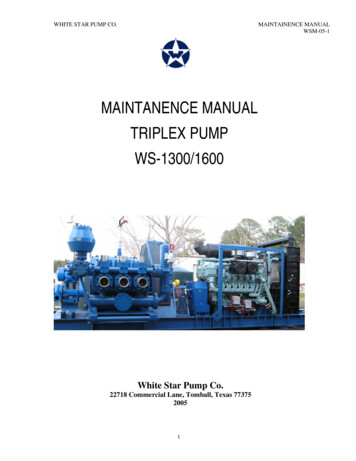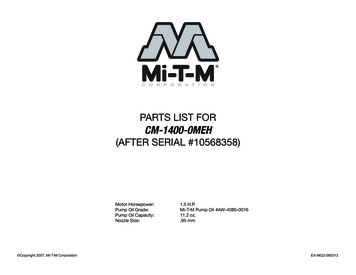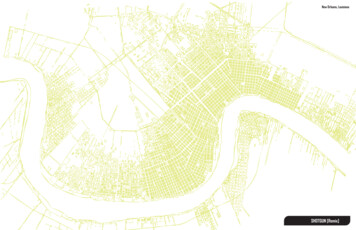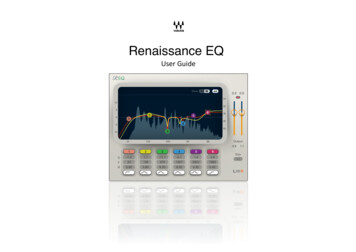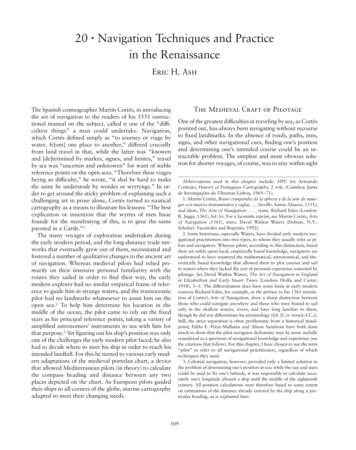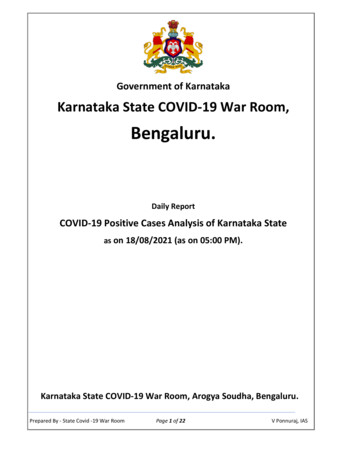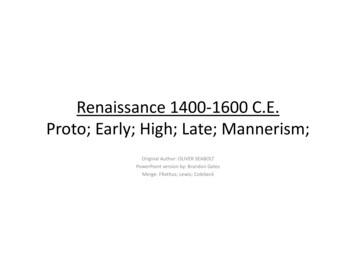
Transcription
Renaissance 1400‐1600 C.E.Proto; Early; High; Late; Mannerism;Original Author: OLIVER SEABOLTPowerPoint version by: Brandon GatesMerge: FRathus; Lewis; Colebeck
Renaissance 14001400‐16001600 A.D. “Rebirth”RebirthOf Classical Greek, Roman CultureOf new iinterest iin science,ililiteratureOf Realism****re‐established western art according toprinciplespp of classical Greek art,, esp.p GreekSculpture & ptg , which remainedunchallangedg until Picasso & Cubism***
Significance‐NotedSignificanceNoted for Reverent revival of classical Greek/roman artforms & style A faith in the nobility of man‐Humanismman Humanism The mastery of linear perspective The naturalization of faces & forms
Humanism “DownplayedDownplayed religious & secular dogma &instead attached the greatest importance tothe dignity & worth of the individualindividual” From Greeksenc .IirishIi i h artt from Pico della Mirandola,Mirandola Renaissance philosopher‐ Man is the center of the universefrom Christianity‐ Man is god’s greatest creation on earth
4 Technological Breakthroughs AML #1 Oil on stretched canvas (before fresco ortempera on wood panels) #2 Perspective (giving weight & depth toform) #3 UseU off lightli h & shadowh d – chiaroscurohi–instead of just drawing lines #4 Pyramid configuration, more 3D,symmetrical compositions climax at center thefocal point, (before horizontal grid inforeground)
#1 technical innovation/breakthrough of Ren.Oil Paints on Canvas (Medium‐(Medium What artwork made of/with) Early paintings:tempera use egg yoke as binder paint Tempera; Egg tempera‐on wood panels, Northern Europe Fresco; waterpaint/pigment into wet plaster; popularin dry climates in central Italy Oil Paints;; vanEycky bros. inventors/1/ st to use,, c1400pigment with turpentine & oil, allows thin glazes,prime & roll upp Canvas; heavyy cotton material, p
Giotto 12661266‐13371337 Arena Chapel 1305 “render“ d humanhformsfwithi h weighti h &roundness Proto‐Renaissance artist‐ transition fromMiddle Ages to Renaissance Cimabue teacher of GiottoArchitect‐ Bell tower for Florence Cathedral Architect
Giotto,Lamentation, 1305,Fresco, ArenaChapel PaduaChapel,Padua, ItalyFresco‐ paintinginto wet plaster
Sculpture:Davidd theh symbolb l off Florencel many artists interpretDavid in sculptureduring the Ren &Baroque times 4 with greatestsignificance diff periods Donatello, Verroccio‐ER Michelangelo‐ High R Bernini‐ Baroque David the patrioticfigure in the republic ofFlorence Early showed as youngboy as described inbible to underscore themiraculous nature ofvictory & divineprovidence Propaganda ‐ large city
Sculpture of David:Early Renaissance1430National MuseumBargello,g , FlorenceDonatelloBronzeEarly Renaissance1473National Museum,Bargello,g , FlorenceVerroccioBronzeHigh aroque1623BorgheseRomeBerniniMarble
Davidby Bernini1623 AD , 67”Early & HighRenaissance – Classical calm; Baroque ACTION
“David by Donatello” First free‐standing malenude figure in 1000 years Religious figure inClassical (pagan) styleEarly Renaissance Early 1430
Verroccio Possible model anapprentice to Verroccio,Da Vinci Body – young teen Moment in time Stancep Head placement‐ Renaissance 1478
MichelangeloStanceMoment in timeHigh Renaissance1501One large stonepreviously rejected Controversial‐nudity
#2 great innovation of RenPerspectivePerspective (giving weight & depth to form)Foundation for European ptg for next 500 yrsCreates illusion of depth on a flat surfaceOptical effect of objects receding in the distancethrough lines that appear to converge at a singlepoint in the picture‐ known as vanishing point Mathematical ppersp.p discovered byy Brunelleschi One point Two point
Brunelleschi & Perspective Brunelleschi artist,artist sculptorsculptor, architect linear Perspective; mathematical perspective Paintingi i surfacefiis a pictureiplanelusedd as awindow Picture is an extension of the onlooker /viewer Parallel lines convergeg at a vanishingg ppoint onthe horizon line Objects reduced in scale
Why so important / impact Key: elevated craft of paining to the level ofmathematical science Rationalized & systematized the visual world Gave man a means to simplify and understandandd therebyh b controllinglli theh worldld aroundd hihim Artists used perspective to make moreconvincing fantasies, make mysteries of faithmore visually compelling (art of the western world)
perspective
perspective Baptistry of Florence Drawing with mirrorslead to discoveryy Competition for doors*
Architect, Cathedral of Florence Dome,1420‐1436; Brunelleschill h
Gates of Paradise Brunelleschi lostcompetition to Ghiberti ((bust insert)) forthe Baptistery ofFlorence Doors
“GatesGates of Paradise”Paradise Michelangelo said upon seeing the gates
“HolyHoly Trinity”Trinity byMasaccio, 1425 A.D. One of the 1st Paintingst fullytof ll utilizetili theth newscientific perspective Illusionistic Santa Maria Novella,NovellaFlorence, Italy
“Holy Trinity” byMasaccio Geometriccompositions Triangularconstruction Symmetrical (visually portrays“mystery”mystery of theCatholic Church‐ 3persons one God)
“Holy Trinity” byMasaccio Maintains traditionalreligious icons Postures & gestures Frontal Hieratic (of orrelating to sacredpersons) uncommunicative
Holy Trinity Orthogonals meet atbase of cross, powerfulillusionaryy tool Patrons replace Mary& John The Baptist Gives appearance ofmaterial substance toa most scared spiritualconceptp ((trinity)y)
The Tribute Money
Tribute Money One point perspectiveHead of ChristRevolutionizedl i i d painting:i iUse of perspective;Consistent source of light‐ accurate shadows;Three‐dimensionalThreedimensional portrayal of the humanfigure
“AimsAims with art not sciencescience” Early mentor Verrochio Involved with Bonfire of Vanities‐ even burnedsome of his ptgs.ptgs Mythological, (portrayed females as nudesbbecausewere mythological)h l i l) Oil on canvas
foreshortening Mantegna 1431‐1506 Married to daughter ofVenetian painter Bellini
High Renaissance: 1500‐1520 A.D. Height of the style 4 great painters, sculptors– LeonardoLd dda VinciVi i– Michelangelo– Raphael– Titian
Why do you know their names? Donatello – early Ren Others from High Ren
Vitruvian Man
Da Vinci “RenaissanceRenaissance Man”,Man , multitalented Artists joined scholars in search for fundamentalcosmic truths of: pproportion,p, order & harmonyy inductive reasoning: observes phenomena directlythen uses information ggathered to developp generalgrules Opposite of medieval deductive reasoning: alreadyaccepted general rules determine how you explainnatural phenomena.
#3 Innovation‐Use of Light andShadowh d ((Chiaroscuro;hlight/dark)l h /d k) Modeling forms in paint Lighter areas seem to emerge from darker Producesdillillusioni off rounded,d d sculpturalll reliefli fon a flat surface
Sfumato SmokyMistHazeBlurrySoft
Famous smile & eyes
Why is Mona appealing Sfumato – blurring technique not just forbackground Used at mouth,mouth eyes and hands “fuzzy” effect‐ left for viewer to “finish”‐ so iti appealingisli to any vieweri
Eyes follow
Eyes follow .
The Art Critic; The AmbassadorsRockwell:k ll Holbeinlb Eyes follow
The Ambassadors 1533, Hans Holbein NG London‐ “universal men”, symbolic point.The technique of painting such distortion is called anamorphosis, (* samemethod used by sidewalk artists)
#4 Innovation of Ren.Pyramid Configuration Symmetrical composition Central/center climax‐ focal point Use off triangles,i l oftenfmultiplesli l
“LastLast Supper”Supper by Leonardo How is the composition organized?– With triangles
“LastLast Supper”Supper by Leonardo How are figures grouped together?– In groups of 3
“LastLast Supper”Supper by Leonardo 11‐pointpoint perspective
4 Technological Breakthroughs(3 out of 4 in Last Supper) #1 Oil on stretched canvas (*LS( LS fresco w oilexperiment on top‐ but failed) #2 Perspective (giving weight & depth toform) #3 UseU off lightli h & shadowh d – chiaroscurohi– #4 Pyramid configuration, more 3D,symmetrical compositions climax at center thefocal point
Restoration 1990’ss1990Sponsored, underwritten by Japanese Comp.ClCleaningi withi h speciali l mildild solventslRemoved previous restorations with gluesFresco with over painting in some places toenhance color extra care needed
4 years to create
Early vs. HighRenaissance More maturefigure contemplative
Michelangelo’ss DavidMichelangelo Large pre cut stone 1st commission inhometown For Duomo‐moreprominent to PlazzopVecchio‐ secular New power for artist,autonomy & freedom/patron & society
Moment in timeBeforeReflection & prayer(god assisted)Face dramaticKnit browsbrows, fierecescowl, leonine hair Ren psychologicalthinking comparehumans to animals
Sculpture of David:Early Renaissance1430National MuseumBargello,g , FlorenceDonatelloBronzeEarly Renaissance1473National Museum,Bargello,g , FlorenceVerroccioBronzeHigh aroque1623BorgheseRomeBerniniMarble
Bernini Baroque‐ 1600truly sculpture in the round
Rome and Florence Artists Concentrated on sculptural forms& epic themes High Renaissance Artists: Leonardo Michelangelo Raphaelp
Titian: 1490‐1576Venetian‐ Fatherh off ModerndPainting
Titian Father of modern painting‐painting oil on canvas Dominant for 60 years StrongSuse off colorsl (Venetian(i colors:lrichi htones: burgendy, emerald green, goldenyellows,llrichi h blues)bl ) First layer red for warmth Vivid hues toned down with 30‐40 layers ofgglazes
#1 innovation of RenRen‐ Oil on canvas Titian‐Titian One of first to abandon wood panelsfor oil on canvas as the typical medium “VenetianVenetian School”‐School Color, texture & mood Other Venetian Artists: Bellini – TitianTitian’ss mentor‐ 1st to integrate figure& landscape, son in law Mantegna Giorgione‐ emotion through light & color Tintoretto, Veronese: large‐scale, majesticstyle of deep coloring & theatricality
Titian at High MuseumOct 17, 2010 ‐ Jan 2, 2011
Architecture RomeRulesReason(A) ‘Rithmetic Alberti 1404‐72– treatiseson Painting, sculpture &Arch. Brunelleschi‐1377‐1446,Bll hi 1377 1446Florence Cathedral dome Bramante 1444‐1514,, order,,simplicity , harmoniousproportions PalladioP ll di 1508‐90,1508 90 villasill &palaces; treatise Four Bookson Architecture
North European Artists Durer 1471‐15281471 1528HolbeinBruegell 1525‐692 69Bosch 1450‐1516Overlap Italian Ren. ArtistsSTYLE: more crisp,crisp detailed,detailed used oil paints,paints
Renaissance vs Late Renaissance &Mannerism HarmonyReasonRealityRealism based onobservationSought equilibriumSymmetrical weightedSymmetrical,in centerNatural lightPrimary colors DissonanceEmotionImaginationExaggerated the idealbeautySought instabilityAsymmetrical void inAsymmetrical,center, figures crowdednear edgeg & cut offArtificial lightJewel & darker colors
Compare‐ MichelangeloHighh Renaissance vs llater Mannerism
MannerismParmigianinogItalian Painter1503‐1540 Madonna with the LongNeck 1534‐40 (*This artwork is oftenusedd to ididentifyifcharacteristics ofMannerism)
Mannerist Style ElongatedgbodiesCompositions oblique with void in centerFiguresgcrowded around centerBodies distortedFigures cut out of the picture“Mannerist‐ sophisticated, elegant style characterizedby elongated forms, irrational spatial relationships,unusuall colorsl andd lilightinghti effects,ff t andd exquisitei it craft.ftThese traits are associated with the style calledMannerism of the 16th Century.”y (Stokstad)()
History of Mannerism The Mannerist Period lasted from 1520 to roughly1600. Movement started as a counter to the art stylesy of theearly Renaissance and the masters. This new art form started in Florence and Rome andeventually spread to the rest of Europe. Mannerism can be considered a link between theclassicism of the Renaissance and the Baroque period *(could not “top” High Ren masters so something new)
Renaissance style in review: Realistic but IdealisticGeometric compositional devicesprimary colors: redsreds, yellowsyellows, bluesgroupings of 3emphasizedh i d handh d motionstinatural lightingscientific perspectivesecularization of religious figures
Late Renaissance & MannerismReview ElongationAsymmetricalSSuggestioni off movementArtificial light with dark areas Leads to Baroque with: *Lights‐Action‐DramaLights Action Drama Caravaggio painter BerniniB i i architecthi& sculptorl
Of Classical Greek, Roman Culture Of new interest in science, literature Of Realism ****re‐established western art according to ppprinciples of classical Greek art, esp. Greek Sculpture & ptg , which remained unchallanged until Picasso & Cubism***

